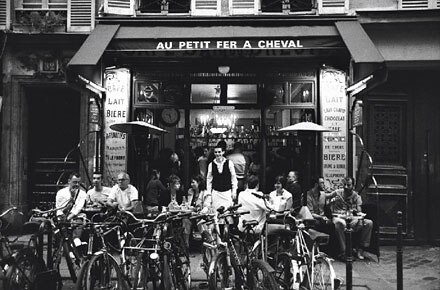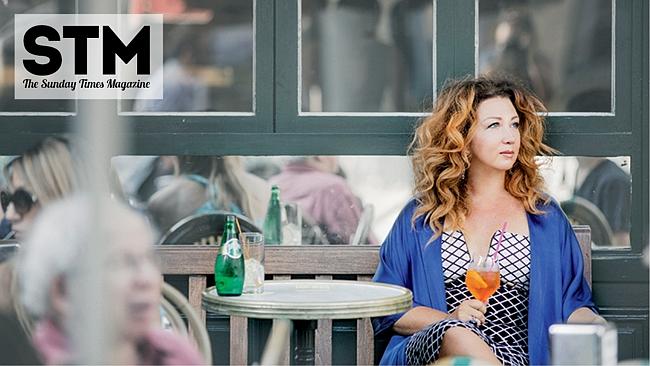Welcome to my Paris
COLOURFUL history and charming locals make the area of Paris where Australian photographer Carla Coulson lives a storyteller's delight.

AFTER 15 months, life in Paris felt sweet. This was a new start, in a new apartment, in a new street. rue Aubriot is narrow, with an ever-so-slight curve. No cars, just cream-stone buildings with carved jolly faces above the doors, faded zinc roofs, a sea of television antennas – and now us.
The Marais sits in the belly of Paris, on the right bank of the Seine River, stretching across the third and fourth arrondissements. Extending from Ile St-Louis (the tiny island that sits between the Left and Right banks), it crosses the Seine and rue de Rivoli and finishes on rue de Bretagne.
The Marais is a living link to Paris's past, having escaped the sweeping changes made by Baron Haussmann that revolutionised the old city in the 1860s.
Under his instructions, the dark, narrow streets and stacked wooden dwellings of medieval Paris were demolished to make way for wide boulevards that created free-flowing traffic.
Large places with grand roundabouts were built to preserve important monuments such as Place de la Concorde, Place de la Bastille and the area around the Arc de Triomphe.
Haussmann razed 27,000 rat-infested houses and built in their place 100,000 light-filled apartment blocks, uniform in design and colour, heralding the new French obsession with symmetry and luminosity.
Classic Paris in the Marais
Miraculously, the Marais, named for the drained swamp on which it was built, survived intact. These streets have seen glory and grandeur, dilapidation and destitution. They have known the splendour of royal palaces, and seen raised swords, duels and deaths.
Four hundred years of life have been played out underneath the perfumed chestnut trees in Paris's oldest square, the Place des Vosges. Generations of children and nannies have played and strolled beneath the perfectly cropped lime trees set in a classic French garden of symmetrical design, all bordered by vaulted arcades and rose-coloured apartment buildings.
During the 17th century, the Marais basked in glory when nobles, lords, courtiers, financiers and the newly wealthy built their hotels particulieres (dream mansions), each searching to outdo the other.
During the French Revolution of 1789, the Marais and her glorious mansions witnessed a mass evacuation for Versailles and the Left Bank. The flight of the nobles marked the beginning of the slow and painful decline from grandeur to gloom that continued well into the 20th century. By the 1950s, the Marais was the closest thing that Paris had to a slum.
When my landlady, Madame Dumas, moved to the Marais from Auvergne in central France in 1955, its once-pristine cream-stone buildings were blackened with soot, the wooden shopfronts were faded and the manicured internal gardens of the grand hotels particulieres were dirt playing fields for neighbourhood soccer matches.
Stories worth bottling
"My parents bought a small restaurant on the corner of rue Sainte Croix de la Bretonnerie and rue Aubriot in the heart of the Marais," explains Mme Dumas. "Each morning at four o'clock, while the rest of Paris slept, our day began. My father and I, wheeling a giant wooden trolley, would cross rue des Archives heading towards rue St Merri and into Les Halles, the belly of Paris."
At 4am, Paris's original fresh-food market was hopping. Among the noise of stallholders calling the daily specials and prices, Mme Dumas and her father jostled with the thousands of restaurant owners who had converged on the centre of Paris to gather daily supplies: "Entering Les Halles was like entering the theatre; it was full of big personalities. There was a certain magic underneath those high glass ceilings."
When they had finished the shopping, with their trolley piled sky-high, they would weave their way home through the winding streets of the Marais.
"Our restaurant, Chez Caumel, was a family affair," says Mme Dumas. "My father did the cooking, my mother organised the bar and my sister and I waited on our customers.
"Our building was typical of most in the Marais. On the first floor, we had two Jewish brothers from Poland who had a small clothing workshop for men, and on the ground floor there was another Jewish gentleman who produced ladies' clothes. On the third floor, there was a hat-maker.
"Chez Caumel was filled at lunchtime with the workers from the ateliers. The Marais had a very distinct rhythm," stresses Mme Dumas. "During the day, it was alive with a flurry of movement, but once five o'clock came there wasn't a soul to be found. My father often said that on Friday night after five, you could drag a table and chairs on to the street and play cards 'til Monday morning at seven and nobody would disturb you."
The Marais has always been the traditional Jewish quarter of Paris. In the early 1900s, the Jews escaping the pogroms in Poland arrived in France and came straight to Le Pletzel ("the little place" in Yiddish), the area around St-Paul Metro, where they were guaranteed to find a friend, a job or the familiar shops that sold herrings, cheesecake and poppyseed strudel.
Many plans have been made over the years to regenerate or raze the Marais. The most drastic was proposed in the 1920s by Swiss architect Le Corbusier. The Plan Voidin was an idea to demolish the whole area and build in its place a series of towers surrounded by fields of green that would inject light and a new life to the decaying quarter.
In 1962, Andre Malraux, the minister for culture during the de Gaulle years, declared the Marais secteur sauvegarde (a protected area), recognising its architectural and historical significance; nothing could be destroyed or altered, not even the original shopfronts. "It was a period of great change ... a terrible time for the inhabitants of the Marais," says Mme Dumas. "They were modest people who had always lived here and they were put under enormous pressure to leave. It was all about money.
"We finished in court with our neighbours, defending our right to stay in our apartments, while the new owners did everything in their power to force us to leave.
"The artisans and ateliers were slowly forced out and were replaced by boutiques, theatres and art galleries."
Changes threatened to rip out the heart of the Marais
The evolution of the Marais continued during the 1960s and '70s, with two important changes. In 1970, Les Halles was finally closed, in a move to clean up the area. The glass-and-steel structure designed by French architect Victor Baltard was dismantled in a cloud of dust.
"For the quarter, it was like a death, like having the heart ripped out of Paris; it was too painful for many of the locals to watch," remembers Mme Dumas. "For almost 10 years, there was a giant hole in the ground, there was a feeling of stagnation and of disorientation; our lifelong habits changed.
"Instead of wheeling our trolley around the corner to Les Halles, we spent two hours in the car travelling to and from the suburb of Rungis to the new market."
The building of the Pompidou Centre was the other big change; it attracted a younger crowd and, around the same time, the first gay bar opened in the Marais.
"We witnessed the evolution in our clientele; during the '50s and '60s, we opened only at lunchtime. The evenings were dead," says Mme Dumas. "Then towards the end of the '70s, the artisans and workshops had ceased and it was the evening that was busy."
Some say that when the Marais scraped the soot off her walls, she lost her soul, but to me the charm of the Marais is the meeting of the ancient and the edgy. When the metro squeals to a stop at St-Paul, buffed and beautiful gay boys file up the stairs next to Jewish men dressed in black suits and tall black hats.
This is the neighbourhood where the magic handshake that Parisians extend to faithful customers is offered to me across bars and counters. At Au Petit Fer a Cheval, an ancient cafe on rue Vieille du Temple, the local characters screech to a halt on their Peugeot 103s like the boys from Bernardo Bertolucci's film The Dreamers.
Standing elbow to elbow, clad in stovepipe jeans with their hair swept across their foreheads, they share the limelight with the local personality Fabrice, the boulanger (baker) from next door who walks the Marais with his cat wrapped around his shoulders like a scarf.
If you look into M Atlan's atelier on rue des Ecouffes, where he tailors jackets for local gentlemen and adjusts jeans for the Marais's finest boutique, L'Eclarieur, you will get a glimpse of the Marais that has almost passed. If you are lucky, as you pass along rue Charles V, you might be treated to a private concert by Harry and Peter as they tune double basses in their atelier for orchestral musicians from around the world. It is this mix that makes the Marais hum - like the kids "krumping" on top of a bus stand along rue de Rivoli during the techno parade, or the shrieks of schoolchildren from rival schools egging each other on during Mardi Gras, racing in huge packs from one street to another, squealing at the tops of their voices.
An insider's guide: Carla Coulson's top 10 things to do in Paris
1. La Maison Europeene de la Photographie. 5 Rue de Fourcy. 4th arrondissement. Metro: St Paul. Wonderful museum exhibiting contemporary and cutting-edge photography.
2. Musee Carnavalet. 23 Rue de Sevigne, 3rd. Metro: Saint-Paul, Chemin Vert. Once a hotel particulier, now the stunning history museum of Paris. Entrance is free, the garden and the building are spectacular and it is in the heart of the Marais.
3. Saturday market at Chateau Rouge. 18th. Exit Metro Chateau Rouge and follow the chaos. A fabulous African market in the 18th arrondissement where buying a baguette is a challenge. Closer to the Congo than the Concorde.
4. Theatre Palais Royale. 38, Rue de Montpensier, 1st. Metro: Palais Royale/Musee de Louvre. See any show in this historic theatre next to La Comedie Francaise and the beautiful gardens of the Palais Royale.
5. Palais de Tokyo. 13 Avenue de President Wilson, 16th. Metro: Alma Marceau. Contemporary art museum. Chicken wire surrounds the very cool Tokyo Eat restaurant, and the art is always a surprise.
6. High tea at the Ritz. 15 Place Vendome, 1st. Metro: Tuileries. Sink into sumptuous sofas and watch the passing parade. You never know who will be there. And the flowers are gorgeous.
7. Retail therapy. Shopping along Rue Vielle du Temple and around rue Poitou in the 3rd. Wonderful individual boutiques and small art galleries abound.
8. People watching. An early morning coffee or aperitif at Au Petit Fer a Cheval on Rue Vielle du Temple. Great people-watching in this tiny Marais bar. Almost impossible to find a seat but leaning at the horseshoe bar is almost as much fun.
9. Chateau d'Eau. If you have a yen to have your hair braided, the area around the Metro Chateau d'Eau is a must. One African hairdresser after another and supermarket-style hairpiece shops.
10. Macaroons. You can't visit Paris without eating one. Laduree has the big reputation but Pain de Sucre on Rue Rambuteau in the Marais is a knockout. The window is enough to make a grown-up cry.
Never-ending scents, faces, sounds
For me, the Marais is a never-ending series of familiar scents, faces and sounds. When I leave my front door, I am treated to the aroma of orange flower and jasmine mixed with roasted lapsang souchong floating out the door of Mariage Freres, as the shop assistants, clad in cream linen uniforms, open ancient tea canisters. On rue des Rosiers, cypress and lemons, rose and honeysuckle drift out of Annick Goutal's exquisite perfumery, mingling with the scent of freshly fried falafels. A couple of doors down, sweet honey and apple strudel beckons as I reach the Jewish bakery Finkelsztajn.
If I feel like a flashback to my childhood, I gaze with awe at the pansy-topped cakes and pastel-coloured marshmallows in giant crystal bowls at Pain de Sucre on rue Rambuteau. Upon entering the florist, Hysope & Cie, I encounter senses-overload: a carpet of sweet peas, lavender, roses and slow-burning baobab bark candles.
Just a couple of doors down on rue Vieille du Temple, Paris's pretty young things knock back miniature glasses of vin blanc, enshrouded in a blanket of cigarette smoke at La Perle.
In 2006, Mme Dumas moved from the Marais to a small village 50km from Paris. She tells me: "I miss the liveliness of the Marais and rhythm of its daily life. Even though getting out my front door on rue Ste Croix de la Bretonnerie was almost impossible on Sundays because of the constant stream of people, I lived in a quiet apartment that opened on to a central courtyard. It is very difficult for me to get used to life in the suburbs; after living 51 years in the Marais with its energy, the streets here seem empty. In the suburbs, there is a mentality that I find difficult to understand.
"Many people in the village have never been to Paris. They have lived their whole life 50km away but they've never seen the Eiffel Tower. I say to them all the time 'Go to Paris. Go to Paris or come with me and I'll show you Paris'."
This is an edited extract from Paris Tango, by Carla Coulson (Lantern, $59.95).



